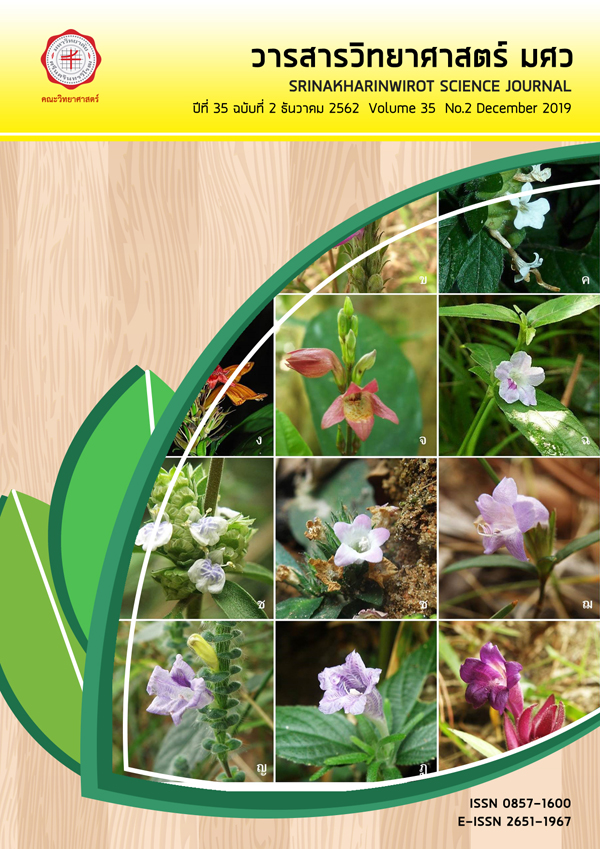Use of Chitosan and Its Derivative as Fungal (Aspergillus niger) Inhibitor on Poly (lactic) acid/ Sisal Biocomposite
Keywords:
biocomposite, biodegradable plastic, chitosan, antifungalAbstract
บทคัดย่อปัจจุบันการใช้พลาสติกจำนวนมหาศาลประกอบกับการจัดการรีไซเคิลที่ไม่สมดุล ส่งผลให้พลาสติกกลายเป็นประเด็นปัญหาสิ่งแวดล้อมระดับโลก ไบโอคอมพอสิตหรือวัสดุเชิงประกอบฐานชีวภาพจึงเป็นวัสดุที่ได้รับการพัฒนาเพื่อมุ่งลดและแทนที่การใช้วัสดุเชิงประกอบฐานปิโตรเคมีและใยแก้ว อย่างไรก็ตาม ปัญหาในการพัฒนาไบโอคอมพอสิต คือ ความเข้ากันได้ระหว่างสารเติมแต่งที่มาจากชีวมวลกับเนื้อพื้นพอลิเมอร์ งานวิจัยครั้งนี้จึงมุ่งพัฒนาไบโอคอมพอสิตจากพอลิแล็กติกแอสิด (poly (lactic) acid, PLA) ซึ่งเป็นพลาสติกย่อยสลายได้ และเสริมแรงด้วยเส้นใยป่านศรนารายณ์ ซึ่งเป็นวัสดุชีวมวล และศึกษาการใช้ไคโตซานและอนุพันธ์ประเภทบิวไทเรตในการยับยั้งการเจริญของเชื้อรา โดยใช้เครื่องมือในการวิเคราะห์สมบัติทางความร้อน โครงสร้างและสัณฐานวิทยาของวัสดุไบโอคอมพอสิตที่เตรียมขึ้น ได้แก่ Fourier transform infrared spectroscopy (FTIR), scanning electron microscope (SEM), differential scanning calorimeter (DSC) และ thermogravimetric analysis (TGA) ผลการศึกษาพบว่า การดัดแปรเส้นใยป่านศรนารายณ์และไคโตซานด้วยการทำปฏิกิริยาเอสเทอริฟิเคชั่น กับบิวไทริกแอนไฮไดรด์ ช่วยปรับปรุงความเข้ากันได้ระหว่างป่านศรนารายณ์ที่เติมเข้าไปกับเนื้อพื้น PLA ได้ดี เห็นได้จากภาพ SEM ทำให้อุณหภูมิการเกิดผลึก (Tc) เพิ่มขึ้น ในขณะที่ระดับความเป็นผลึก (%Xc) ลดลง หลังการทดสอบเพาะเชื้อ Aspergillus niger พบว่า ไบโอคอมพอสิตเกิดการเสื่อมสภาพเนื่องจากเอนไซม์ สังเกตได้จากการที่หมู่เอสเทอร์ของ PLA ลดลง แต่เกิดหมู่ไฮดรอกซิลขึ้นมาแทน ในขณะที่ไบโอคอมพอสิตที่เติมไคโตซานไม่มีหมู่ไฮดรอกซิลเกิดขึ้น จะเห็นได้ว่า ไคโตซานและอนุพันธ์บิวไทเรตไคโตซานมีผลในการยับยั้งการเจริญของเชื้อราบนวัสดุไบโอคอมพอสิต PLA/ ป่านศรนารายณ์คำสำคัญ: ไบโอคอมพอสิต วัสดุคอมพอสิตชีวภาพ พลาสติกย่อยสลายได้ทางชีวภาพ ไคโตซาน การยับยั้งเชื้อราABSTRACTPresently, massive plastic consumption and unbalanced recycle management lead us to an environmentally global issue. Biocomposite has been considered as beneficial material to reduce and replace typical glass fibre reinforced composite derived from petrochemicals. However, one major concern when developing biocomposite is compatibility between biomass-based reinforced filler and polymeric matrix. The objectives of this research were to develop a biocomposite composed of poly(lactic) acid (PLA), a biodegradable plastic, and biomass-based reinforced filler, sisal, and study the role of chitosan and its butyrate modified derivative as fungal inhibitors. Several techniques, such as Fourier transform infrared spectroscopy (FTIR), scanning electron microscope (SEM), differential scanning calorimeter (DSC), and thermogravimetric analysis (TGA) were utilized to investigate the chemical structure, surface morphology, thermal and mechanical behaviour of PLA/sisal biocomposite. It is shown in SEM images that the modification of chitosan and sisal filler through butyric anhydride esterification, improves compatibility between sisal reinforced filler and PLA matrix, resulting in higher crystallization temperature (Tc), and lower %crystallinity (%Xc). After Aspergillus niger culture test, enzymatic degradation of biocomposite can be noticed from the reduction of ester group of PLA and the addition of hydroxyl group. However, the antifungal activities of all PLA/ sisal biocomposites with chitosan added are improved where no identical hydroxyl group is observed after the tests. As a result, chitosan and its butyrate modified derivative are effective antifungals for PLA/sisal biocomposite.Keywords: biocomposite, biodegradable plastic, chitosan, antifungalDownloads
Download data is not yet available.
Downloads
Published
2019-08-30
How to Cite
Jitjaicham, S., Malakul, R., & Kittikorn, T. (2019). Use of Chitosan and Its Derivative as Fungal (Aspergillus niger) Inhibitor on Poly (lactic) acid/ Sisal Biocomposite. Science Essence Journal, 35(2), 1–16. Retrieved from https://ejournals.swu.ac.th/index.php/sej/article/view/10658
Issue
Section
Research Article








